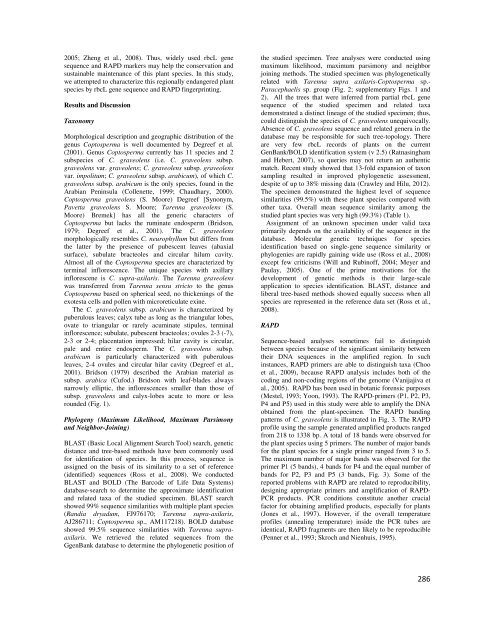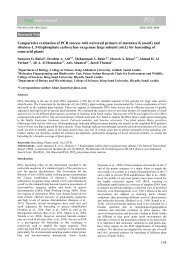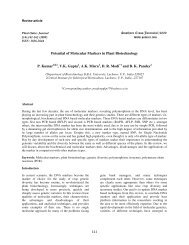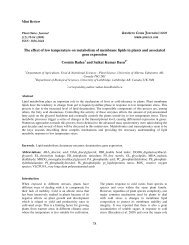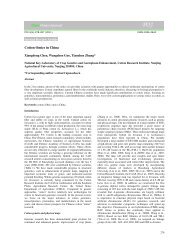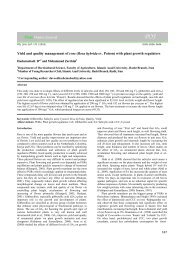Ribulose-1, 5-biphosphate carboxylase (rbcL) gene ... - Plant Omics
Ribulose-1, 5-biphosphate carboxylase (rbcL) gene ... - Plant Omics
Ribulose-1, 5-biphosphate carboxylase (rbcL) gene ... - Plant Omics
You also want an ePaper? Increase the reach of your titles
YUMPU automatically turns print PDFs into web optimized ePapers that Google loves.
2005; Zheng et al., 2008). Thus, widely used <strong>rbcL</strong> <strong>gene</strong><br />
sequence and RAPD markers may help the conservation and<br />
sustainable maintenance of this plant species. In this study,<br />
we attempted to characterize this regionally endangered plant<br />
species by <strong>rbcL</strong> <strong>gene</strong> sequence and RAPD fingerprinting.<br />
Results and Discussion<br />
Taxonomy<br />
Morphological description and geographic distribution of the<br />
genus Coptosperma is well documented by Degreef et al.<br />
(2001). Genus Coptosperma currently has 11 species and 2<br />
subspecies of C. graveolens (i.e. C. graveolens subsp.<br />
graveolens var. graveolens; C. graveolens subsp. graveolens<br />
var. impolitum; C. graveolens subsp. arabicum), of which C.<br />
graveolens subsp. arabicum is the only species, found in the<br />
Arabian Peninsula (Collenette, 1999; Chaudhary, 2000).<br />
Coptosperma graveolens (S. Moore) Degreef [Synonym,<br />
Pavetta graveolens S. Moore; Tarenna graveolens (S.<br />
Moore) Bremek] has all the <strong>gene</strong>ric characters of<br />
Coptosperma but lacks the ruminate endosperm (Bridson,<br />
1979; Degreef et al., 2001). The C. graveolens<br />
morphologically resembles C. neurophyllum but differs from<br />
the latter by the presence of pubescent leaves (abaxial<br />
surface), subulate bracteoles and circular hilum cavity.<br />
Almost all of the Coptosperma species are characterized by<br />
terminal inflorescence. The unique species with axillary<br />
inflorescene is C. supra-axilaris. The Tarenna graveolens<br />
was transferred from Tarenna sensu stricto to the genus<br />
Coptosperma based on spherical seed, no thickenings of the<br />
exotesta cells and pollen with microreticulate exine.<br />
The C. graveolens subsp. arabicum is characterized by<br />
puberulous leaves; calyx tube as long as the triangular lobes,<br />
ovate to triangular or rarely acuminate stipules, terminal<br />
inflorescence; subulate, pubescent bracteoles; ovules 2-3 (-7),<br />
2-3 or 2-4; placentation impressed; hilar cavity is circular,<br />
pale and entire endosperm. The C. graveolens subsp.<br />
arabicum is particularly characterized with puberulous<br />
leaves, 2-4 ovules and circular hilar cavity (Degreef et al.,<br />
2001). Bridson (1979) described the Arabian material as<br />
subsp. arabica (Cufod.) Bridson with leaf-blades always<br />
narrowly elliptic, the inflorescences smaller than those of<br />
subsp. graveolens and calyx-lobes acute to more or less<br />
rounded (Fig. 1).<br />
Phylogeny (Maximum Likelihood, Maximum Parsimony<br />
and Neighbor-Joining)<br />
BLAST (Basic Local Alignment Search Tool) search, <strong>gene</strong>tic<br />
distance and tree-based methods have been commonly used<br />
for identification of species. In this process, sequence is<br />
assigned on the basis of its similarity to a set of reference<br />
(identified) sequences (Ross et al., 2008). We conducted<br />
BLAST and BOLD (The Barcode of Life Data Systems)<br />
database-search to determine the approximate identification<br />
and related taxa of the studied specimen. BLAST search<br />
showed 99% sequence similarities with multiple plant species<br />
(Randia dryadum, FJ976170; Tarenna supra-axilaris,<br />
AJ286711; Coptosperma sp., AM117218). BOLD database<br />
showed 99.5% sequence similarities with Tarenna supraaxilaris.<br />
We retrieved the related sequences from the<br />
GgenBank database to determine the phylo<strong>gene</strong>tic position of<br />
the studied specimen. Tree analyses were conducted using<br />
maximum likelihood, maximum parsimony and neighbor<br />
joining methods. The studied specimen was phylo<strong>gene</strong>tically<br />
related with Tarenna supra axilaris-Coptosperma sp.-<br />
Paracephaelis sp. group (Fig. 2; supplementary Figs. 1 and<br />
2). All the trees that were inferred from partial <strong>rbcL</strong> <strong>gene</strong><br />
sequence of the studied specimen and related taxa<br />
demonstrated a distinct lineage of the studied specimen; thus,<br />
could distinguish the species of C. graveolens unequivocally.<br />
Absence of C. graveolens sequence and related <strong>gene</strong>ra in the<br />
database may be responsible for such tree-topology. There<br />
are very few <strong>rbcL</strong> records of plants on the current<br />
GenBank/BOLD identification system (v 2.5) (Ratnasingham<br />
and Hebert, 2007), so queries may not return an authentic<br />
match. Recent study showed that 13-fold expansion of taxon<br />
sampling resulted in improved phylo<strong>gene</strong>tic assessment,<br />
despite of up to 38% missing data (Crawley and Hilu, 2012).<br />
The specimen demonstrated the highest level of sequence<br />
similarities (99.5%) with these plant species compared with<br />
other taxa. Overall mean sequence similarity among the<br />
studied plant species was very high (99.3%) (Table 1).<br />
Assignment of an unknown specimen under valid taxa<br />
primarily depends on the availability of the sequence in the<br />
database. Molecular <strong>gene</strong>tic techniques for species<br />
identification based on single-<strong>gene</strong> sequence similarity or<br />
phylogenies are rapidly gaining wide use (Ross et al., 2008)<br />
except few criticisms (Will and Rubinoff, 2004; Meyer and<br />
Paulay, 2005). One of the prime motivations for the<br />
development of <strong>gene</strong>tic methods is their large-scale<br />
application to species identification. BLAST, distance and<br />
liberal tree-based methods showed equally success when all<br />
species are represented in the reference data set (Ross et al.,<br />
2008).<br />
RAPD<br />
Sequence-based analyses sometimes fail to distinguish<br />
between species because of the significant similarity between<br />
their DNA sequences in the amplified region. In such<br />
instances, RAPD primers are able to distinguish taxa (Choo<br />
et al., 2009), because RAPD analysis includes both of the<br />
coding and non-coding regions of the genome (Vanijajiva et<br />
al., 2005). RAPD has been used in botanic forensic purposes<br />
(Mestel, 1993; Yoon, 1993). The RAPD-primers (P1, P2, P3,<br />
P4 and P5) used in this study were able to amplify the DNA<br />
obtained from the plant-specimen. The RAPD banding<br />
patterns of C. graveolens is illustrated in Fig. 3. The RAPD<br />
profile using the sample <strong>gene</strong>rated amplified products ranged<br />
from 218 to 1338 bp. A total of 18 bands were observed for<br />
the plant species using 5 primers. The number of major bands<br />
for the plant species for a single primer ranged from 3 to 5.<br />
The maximum number of major bands was observed for the<br />
primer P1 (5 bands), 4 bands for P4 and the equal number of<br />
bands for P2, P3 and P5 (3 bands, Fig. 3). Some of the<br />
reported problems with RAPD are related to reproducibility,<br />
designing appropriate primers and amplification of RAPD-<br />
PCR products. PCR conditions constitute another crucial<br />
factor for obtaining amplified products, especially for plants<br />
(Jones et al., 1997). However, if the overall temperature<br />
profiles (annealing temperature) inside the PCR tubes are<br />
identical, RAPD fragments are then likely to be reproducible<br />
(Penner et al., 1993; Skroch and Nienhuis, 1995).<br />
286


